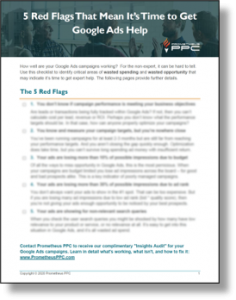Search Engine Optimization: A Google-Approved Strategy
Thousands of blog posts and articles delve into the nitty-gritty about how to perform search engine optimization on a web page without leading to “keyword stuffing”. This won’t be one of them. I will point you to three of the best on-page SEO sources at the end of this post, but I want to do something more. I want to give you a “Google Approved” strategy for search engine optimization that requires thinking about SEO and keywords a bit differently.

The reason SEO has a bad reputation in many quarters is because of all the awful tricks and shortcuts some “professionals” implement for their clients. What you find is that even though some of those shortcuts may work for a while, Google will catch on.
Google employs thousands of the smartest technical folks on the planet. For many of them “Job #1” is to improve Google’s search results by ceasing to reward unseemly search engine optimization techniques. So don’t kid yourself into thinking that any nifty SEO shortcut will work for long. Google will outsmart you eventually.
So, what should you do? I’ll talk about sensible off-site SEO (backlink building) in a later post. In this post, I’ll focus on how to SEO-optimize your individual web site pages to give you the best results without risking running afoul of Google.
Ask yourself, “How can I help Google today?”
When I was in the corporate world, I once heard a piece of advice that nearly single-handedly ensured my success for as long as I wanted it. The advice was simply this:
Ask yourself every morning when you get to work:
“What can I do today to make my boss’ life easier?”
That’s it. If you ask, and answer, that question every day, you’ll end up with a boss who’d sell his soul to keep you around.
That same advice applies to Google — your online boss. Ask yourself, “How can I help Google deliver the best search results today?” Your resulting search engine optimization strategy will forever keep you in Google’s good graces.
How to help yourself by helping Google
Google wants to continue to dominate the online search engine space. There’s only one way to do that — by continuing to deliver the most relevant and useful results to searchers. That’s it. Everything else is secondary.
So how do you help Google? By making it crystal clear for which search terms your site should be shown in search results.
You do this through 3 steps:
- Optimize each page for only a single keyword
- Give that keyword all the prime real estate on the page
- Keep the writing natural and helpful for human visitors
Focus on the 5 most important areas on a page to promote your keyword. These are the big ticket items. There’s more you can do to push past this 80/20 point, and you’ll find those tips at the end of this post. I want to focus on what gives you the biggest bang for the buck.
The 5 most important page elements to optimize for keywords are:
- The URL
- The Page Title – The name you see in your browser tab and the heading you see when your page shows up in search results
- The Meta Description field – The description that you often see when your page shows up in search results
- The Body <h1> tag – The main header on the page
- The Body <p> tag – The page content
In all cases, the closer the keyword is to the front of the element, the more importance it is given.
This is why you can only fully optimize a single page for a single keyword. Only one keyword can be given priority placement.
Note that the Meta Description field is less important from a search engine point of view, but more important from a searcher point of view. This description is often (though not always) used by search engines when displaying the page in search results. So its this description, along with the page title, that entices searchers to click through to your web page.
Also note that you can’t always get your keywords into the URL — either easily or at all. For example, your home page is likely just your domain name. There’s not much you can do about that, so don’t lose sleep over it.
On-Page Search Engine Optimization — The Good and the Bad
Bad Example — No keyword alignment
You’ll see web pages like the following all the time
- URL: www.xyz.com/products
- Title: The XYZ.com Store
- Meta Description: <missing>
- Body <h1> tag: We Sell Premium Widgets
- Body <p> tag: If you want widgets, you’ve come to the right place. We have blue ones, green ones, red ones…
Now what, exactly, is Google supposed to think this page is about? Is it about the XYZ company? Is it about products? Is it about a store? Is it about widgets?
Good Example — Full keyword alignment
Here’s an SEO-Optimized page:
- URL: www.xyz.com/blue-widgets
- Title: Blue Widgets for Car Manufacturers
- Meta Description: We provide top quality blue widgets to car manufacturers nationwide with volume discounts and free next-day shipment.
- Body <h1> tag: Blue Widgets When you Need Them
- Body <p> tag: American car manufacturers need to keep assembly lines moving 24/7 to remain competitive. That’s why we pride ourselves in providing next day shipments of crucial blue widgets upon a moment’s notice…
In this second case the keyword alignment is clear. It is about blue widgets. Further, it is about blue widgets for car manufacturers. Google now knows exactly when this page should be shown in search results, thanks to the clear intent.
Now, you might look at this and say, “Wait a minute. That looks like keyword stuffing! Google hates keyword stuffing!”
That’s true. Google hates keyword stuffing. Keyword stuffing is including 100 instances of a keyword on a page in unnatural English usage. Keyword stuffing is filling meta fields with lists of dozens of keywords. Keyword stuffing is using the phrase “keyword stuffing” 7 times in two paragraphs (ahem).
That’s not what we’re doing.
We’re doing keyword “alignment”. We’re making all the key page elements agree that this keyword is the single most important topic of this page. And we’re doing it in a way that is not only completely natural to human readers but also immediately reassures them that they’ve come to the right place.
Still skeptical? Google “Boston dance classes”. Within the top 3 listings, and most often at #1, you’ll find one of my personal sites: www.dancenut.com.
Keyword alignment for Dance Nut
- URL: n/a (it’s the home page)
- Title: Boston Dance Classes
- Meta Description: Boston dance classes, studios, clubs and events. The easy way to find dancing around Boston, MA!
- Body <h1> tag: Boston Dance Classes
- Body <p> tag: Find dance classes, events, studios, clubs, teachers and more in the Boston area… Home of Boston Dance Classes and Boston Dance Information…
www.dancenut.com has topped the Google results for “Boston Dance Classes” for more than a year. And it’s done so by beating out other sites that have stronger site authority (stronger back links and citations), but which don’t have full search engine optimization for this specific keyword.
This isn’t cheating Google. This is helping Google. This page is, indeed, all about Boston Dance Classes (if it wasn’t, Google would figure that out), which makes the visitor experience better when clicking through from the search results, which makes Google happy.
Conclusion
Stop thinking of Google as the enemy that you need to outsmart. Instead, think of Google as the friend you want to help.
Be consistent and complete in your search engine optimization to let Google know exactly what your web page is about, and Google will reward you.
P.S. — What about those helpful links for more detailed search engine optimization? Here you go.


4 Comments